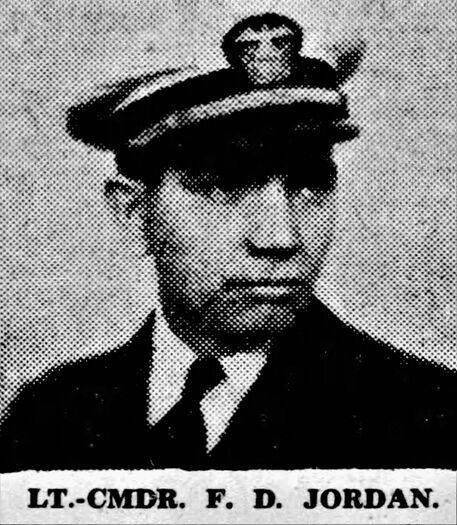FRANCIS D. JORDAN, LCDR, USN
Francis Jordan '29
Lucky Bag
From the 1929 Lucky Bag:
FRANCIS DIXON JORDAN
Raleigh, North Carolina
"Flash" "Horse" "Dick"
A PERSISTENT spirit, along with an almost uncanny ability to use a flashlight, enabled Flash to emerge from the pine forests of his native state and seek his way to fame and fortune in wider fields. Following in the footsteps of an older brother he chose the Navy as the most suitable field in which to display his talents.
It was not without difficulty that he finally arrived among us. After an unsuccessful attempt to enter with "Twenty-Eight," he enlisted in the Navy and his persistence was rewarded when he joined us late Plebe summer.
A never-ending source of amusement to those with whom he comes in contact, Horse immediately became immensely popular with the upper classes and his Plebe year was the kind now only thought of as part of the "Old Navy." His tales of horrors of that last coal-burning cruise are also a part of the "Old Navy," but in spite of it all, or perhaps because of it all, he has consistently remained a true Southern gentleman, true to the little girl back home, and always a loyal friend and classmate.
Black N. Class Gym 2. Sub-Squad 4, 3, 2. 2 P.O.

FRANCIS DIXON JORDAN
Raleigh, North Carolina
"Flash" "Horse" "Dick"
A PERSISTENT spirit, along with an almost uncanny ability to use a flashlight, enabled Flash to emerge from the pine forests of his native state and seek his way to fame and fortune in wider fields. Following in the footsteps of an older brother he chose the Navy as the most suitable field in which to display his talents.
It was not without difficulty that he finally arrived among us. After an unsuccessful attempt to enter with "Twenty-Eight," he enlisted in the Navy and his persistence was rewarded when he joined us late Plebe summer.
A never-ending source of amusement to those with whom he comes in contact, Horse immediately became immensely popular with the upper classes and his Plebe year was the kind now only thought of as part of the "Old Navy." His tales of horrors of that last coal-burning cruise are also a part of the "Old Navy," but in spite of it all, or perhaps because of it all, he has consistently remained a true Southern gentleman, true to the little girl back home, and always a loyal friend and classmate.
Black N. Class Gym 2. Sub-Squad 4, 3, 2. 2 P.O.
Loss
Francis was lost when the Japanese "Hell Ship" he was aboard, Arisan Maru, was sunk by an American submarine on October 24, 1944.
He was the executive officer of USS Luzon (PG 47) until that ship was scuttled in Manila Bay on May 6, 1942, shortly before Corregidor was surrendered.
Other Information
From researcher Kathy Franz:
Francis went by Dixon in school and graduated from Raleigh high school in 1923. He played the part of Lord Times in the senior play “A Kiss for Cinderella.” General Appearance: Gentlemanly. Aim in Life: Build a bridge across the Pacific. Chief Virtue: Ambition. Always: Asking questions. Senior Prophecy: Dixon Jordan is a naval officer.
Born and raised in Raleigh, he enlisted in the Navy on August 15, 1924. He was sent to Hampton Roads, Virginia, for training. He was a seaman second class when he passed the examination for the Naval Academy.
In December, 1929, Francis was ordered to duty on the Staff of Rear Admiral Bostwick, Commander of the Battleships Divisions of the U. S. Battle Fleet.
From 1932-1933, he was assistant to Commander Rosendahl in the lighter than air service.
Francis married Katherine Dorothy Hughes on June 8, 1933, at her parents’ home in Raleigh, North Carolina. His second wife was Rowena Cook of Shanghai. They married in Shanghai in 1940. Their son, Francis Dixon Jordan, Jr., was born on August 6, 1941, in Raleigh while Francis was on duty on the U. S. S. Luzon in Shanghai.
In December, 1934, Japan requested the United States to withdraw diplomatic immunity privileges accorded to American army and navy officers assigned to the embassy in Tokyo as language students. Francis was one of the navy students.
In July, 1938, his sister Julia showed a motion picture to friends that Francis made in Japan and during his return trip home via the Near East and Europe.
Francis was promoted to lieutenant commander in November, 1941.
He was reported missing in action on May 9, 1942. In March, 1943, he was reported by the Navy to be a prisoner of the Japanese in the Philippines.
Francis’ name, along with many others, was inscribed on the World War II memorial in front of the Wake County Courthouse in Raleigh.
His father Thomas was a physician who died in 1933. Francis was survived by his mother Ida and brother Lt. Cmdr. Leslie L. Jordan of Redlands, Cal. His four surviving sisters were Julia, Betty (Mrs. C. E. Bell,) Ida (Mrs. D. H. Wigg) of Norfolk and Mary Alice (Mrs. J. T. Lazar) of Florence, S.C.
Francis was in a Japanese immersion program in 1934-1937.
His wife was listed as next of kin. He has a memory marker in North Carolina.
Photographs
Prisoner of War Medal
From Hall of Valor:
Lieutenant Commander Francis D. Jordan (NSN: 0-62589), United States Navy, was captured by the Japanese after the fall of Corregidor, Philippine Islands, on 6 May 1942, and was held as a Prisoner of War until his death while still in captivity.
General Orders: NARA Database: Records of World War II Prisoners of War, created, 1942 - 1947
Service: Navy
Rank: Lieutenant Commander
The "Register of Commissioned and Warrant Officers of the United States Navy and Marine Corps" was published annually from 1815 through at least the 1970s; it provided rank, command or station, and occasionally billet until the beginning of World War II when command/station was no longer included. Scanned copies were reviewed and data entered from the mid-1840s through 1922, when more-frequent Navy Directories were available.
The Navy Directory was a publication that provided information on the command, billet, and rank of every active and retired naval officer. Single editions have been found online from January 1915 and March 1918, and then from three to six editions per year from 1923 through 1940; the final edition is from April 1941.
The entries in both series of documents are sometimes cryptic and confusing. They are often inconsistent, even within an edition, with the name of commands; this is especially true for aviation squadrons in the 1920s and early 1930s.
Alumni listed at the same command may or may not have had significant interactions; they could have shared a stateroom or workspace, stood many hours of watch together… or, especially at the larger commands, they might not have known each other at all. The information provides the opportunity to draw connections that are otherwise invisible, though, and gives a fuller view of the professional experiences of these alumni in Memorial Hall.
July 1929
October 1929
January 1930
April 1930
ENS Cyrus Clendening '27 (USS West Virginia)
October 1930
LTjg Theodore Marshall '24 (Observation Plane Squadron (VO) 5B)
January 1931
LTjg Theodore Marshall '24 (Observation Plane Squadron (VO) 5B)
April 1931
July 1931
October 1931
January 1932
ENS Robert Germany, Jr. '30 (Battleship Division 4)
April 1932
ENS Robert Germany, Jr. '30 (Battleship Division 4)
October 1932
January 1933
April 1933
July 1933
October 1933
April 1934
July 1934
October 1934
January 1935
April 1935
October 1935
CDR Samuel Moore '13
LT William Gray '21
LT John French '22
LT Howard Healy '22
LT Edward Metcalfe '22
LT Eugene Elmore '22
LT Richard Gingras '25
LTjg Ralph Hickox '27
January 1936
CDR Samuel Moore '13
LT William Gray '21
LT John French '22
LT Howard Healy '22
LT Edward Metcalfe '22
LT Eugene Elmore '22
LT Richard Gingras '25
LTjg Ralph Hickox '27
April 1936
July 1936
January 1937
April 1937
September 1937
January 1938
July 1938
June 1940
November 1940
April 1941

The "category" links below lead to lists of related Honorees; use them to explore further the service and sacrifice of alumni in Memorial Hall.

